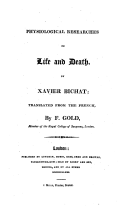The Difference Between Vegetable and Animal
Thus it might be said, that the vegetable is only the sketch, nor rather the ground-work of the animal; that for the formation of the latter, it has only been requisite to clothe the former with an apparatus of external organs, by which it might be connected with external objects.
From hence it follows, that the functions of the animal are of two very different classes. By the one (which is composed of an habitual succession of assimilation and excretion) it lives within itself, transforms into its proper substance the particles of other bodies, and afterwards rejects them when they are become heterogeneous to its nature. By the other, it lives externally, is the inhabitant of the world, and not as the vegetable of a spot only; it feels, it perceives, it reflects on its sensations, it moves according to their influence, and frequently is enabled to communicate by its voice its desires, and its fears, its pleasures, and its pains.
The aggregate of the functions of the first order, I shall name the organic life, because all organized beings, whether animal or vegetable, enjoy it more or less, because organic texture is the sole condition necessary to its existence. The sum of the functions of the second class, because it is exclusively the property of the animal, I shall denominate the animal life.
Notes:
A lovely description.
Folksonomies: life plant animal. taxonomy
Taxonomies:
/food and drink (0.320819)
/pets/animal welfare (0.248641)
/business and industrial/agriculture and forestry/crops and seed (0.149876)
Keywords:
lovely description (0.932678 (positive:0.641671)), habitual succession (0.925730 (negative:-0.361768)), vegetable (0.908983 (positive:0.183391)), external organs (0.892619 (negative:-0.262924)), external objects (0.875655 (neutral:0.000000)), proper substance (0.861786 (neutral:0.000000)), different classes (0.854948 (negative:-0.307373)), voice its desires (0.850628 (positive:0.364629)), organized beings (0.826867 (positive:0.220846)), sole condition (0.820894 (positive:0.246582)), organic texture (0.800457 (positive:0.246582)), organic life (0.766397 (positive:0.329966)), animal life (0.763029 (neutral:0.000000)), functions (0.618321 (negative:-0.277949)), excretion (0.537806 (negative:-0.361768)), inhabitant (0.531437 (neutral:0.000000)), assimilation (0.523582 (negative:-0.361768)), sensations (0.519909 (neutral:0.000000)), pains (0.518300 (negative:-0.302861)), Difference (0.507729 (positive:0.641671)), pleasures (0.507575 (positive:0.309997)), sum (0.502359 (negative:-0.248525)), particles (0.501231 (neutral:0.000000)), fears (0.500355 (neutral:0.000000)), aggregate (0.494450 (neutral:0.000000)), apparatus (0.489647 (negative:-0.262924)), formation (0.489121 (negative:-0.311972)), sketch (0.488600 (negative:-0.471237)), bodies (0.485530 (neutral:0.000000)), existence (0.484966 (positive:0.246582))
Concepts:
Ontology (0.943932): dbpedia | freebase | opencyc
Life (0.942192): dbpedia | freebase
Metaphysics (0.940458): dbpedia | freebase | opencyc
Animal (0.823890): dbpedia | freebase | opencyc
Addition (0.807415): dbpedia | freebase
Supply and demand (0.799926): dbpedia | freebase
Being (0.781363): dbpedia | freebase
Object (0.769629): dbpedia | freebase





